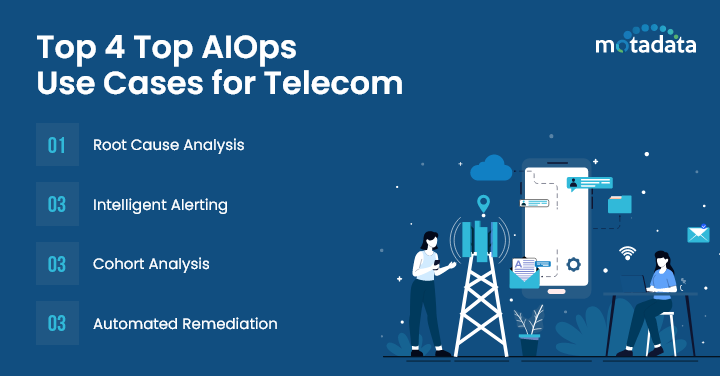The telecom industry is rapidly evolving, with network operations becoming increasingly complex. To navigate this complexity, telecom operators are turning to Artificial Intelligence for IT Operations (AIOps) solutions.
AIOps combines artificial intelligence, machine learning, and big data analytics to optimize network performance, enhance customer experience, and drive business outcomes.
In this blog, we will explore the challenges, benefits, and use cases of AIOps in the telecom industry, and how it is transforming the future of telecommunications.
Understanding the Role of AIOps in Telecom Industry
Telecom operators face numerous challenges in managing network operations. AIOps for telecom industry helps in tackling these challenges by leveraging advanced algorithms and generative AI.
AIOps optimizes network complexity management, customer behavior analytics, anomaly detection, and network automation in telecommunications.
With AIOps, telecom operators gain agility, visibility, and actionable insights for network management, incident management, and service assurance in an increasingly digital and data-driven environment.
The Evolution of AIOps in the Telecom Sector
AIOps has evolved in response to the growing complexity of telecommunications networks and the need for improved network management. Telecom operators are leveraging AIOps solutions for predictive maintenance, automation, and anomaly detection.
AIOps algorithms analyze network traffic, customer behavior, and network performance, allowing operators to optimize network operations. With the adoption of AIOps, telecom operators can proactively identify network issues, enhance network performance, and optimize resources for improved quality of service.
The Growing Importance of AIOps for Telecom Operators
AIOps is becoming increasingly important for telecom operators as it enables them to prioritize actionable insights, enhance customer satisfaction, and improve network performance.
Telecom operators can leverage AIOps solutions to analyze customer feedback, predictive maintenance analytics, and network latency deviations management.
By optimizing network traffic and leveraging AI for streamlining routine tasks, AIOps solutions in the telecom industry are transforming network operations, customer experience, and business outcomes.
Top 4 Challenges That Telecom Industry Face Today
1. Cost
Today, the telecom industry finds itself in a tight spot where they need to invest hugely in 5G technology but at the same time they aren’t earning much in their call and texts business.
To make their lives a bit easier, these businesses are looking for ways to work smarter and not harder. This has led them to venture into the realms of automation and artificial intelligence.
2. Scale
Scalability in technologies like 5G and edge computing is a challenge due to its complex and distributed nature. In addition, it also requires a lot of people to keep it running which is something that not all telecom companies can afford.
3. Quality
With rising user expectations and competition within the industry, delivering a quality service has become crucial for telecom businesses.
Here, by quality service, we mean:
- Service responsiveness
- Network performance
- Data security
- Global connectivity
4. Technology Convergence
Another major challenge telecom companies face is to adapt themselves from decade-old industry technologies to new-age technologies like virtualization, cloud, containerization, etc.
To be successful, telecom companies need technological transformation which ultimately calls for an operational transformation.
7 Benefits of AIOps for Telecom Industry
1. Improved Customer Experience
AIOps does a fantastic job at analyzing data from customer feedback to identifying recurring patterns and issues. With this, telecom businesses can proactively address issues to stop them from impacting customers.
For instance, if there are consistent complaints of slower internet speeds, AIOps can find the root cause of the issue and take subsequent courses of action to resolve the issue before any customer gets affected.
2. Anomaly Detection
Telecom is highly susceptible to anomalies like:
- Data breach
- Identity theft
- Fraudulent transactions
AIOps trains telecom businesses with advanced ML algorithms to overcome all the above anomalies. These algorithms generate patterns that help in anomaly detection with high accuracy. Once the anomalies are predicted, they are prioritized, helping in establishing a no-panic environment for the business.
3. Customer Segmentation
AIOps helps telecom businesses a great deal when it comes to customer segmentation. Generally, the customers are grouped into different segments based on billing information, opt services, payment types, revenue generation, etc.
AIOps then finds these segments and give them better and real-time suggestions that influences buying behavior and enhances upselling capacity of the customer.
4. Improving Network Performance
AIOps monitors network traffic and identifies all the potential points where congestion could occur. Businesses can use this information to reroute their traffic along with adding additional capacity for prevention of outages and slowdowns.
Not only this, but AIOps also detects and diagnoses network issues in real-time, helping operators to resolve or minimize downtime quickly.
5. Reducing Costs
AIOps can automate a lot of manual tasks like network monitoring and troubleshooting that require human operators. This significantly reduces the need for any additional staff, allowing you to allocate resources efficiently.
6. Increasing Agility
AIOps can help telecom operators to respond more quickly to changes in network demand and traffic patterns. For example, if a sudden spike in traffic is detected, AIOps can automatically allocate additional resources to prevent slowdowns or outages.
7. Improved Compliance
AIOps plays a major role in helping telecom operators to get compliance with the regulations. AIOps does this by monitoring network activities to check for any potential violations along with providing insightful reports on network security and performance.
This is a crucial benefit for telecom operators as it helps them avoid fines & penalties associated with non-compliance.
Top 4 Top AIOps Use Cases for Telecom
1. Root Cause Analysis
Automated root cause analysis is one of the top AIOps use cases for telecom industry. As the name suggests, it identifies the actual cause of an issue. Further, it uses information from past events to figure out the most probable reason for an incident, as part of understanding what’s going on across different areas.
2. Intelligent Alerting
AIOps collects information from different parts of the IT system and organizes it into ‘incidents.’ This stops a flood of alerts and instances when a problem in one system sets off alerts in another.
Smart alerting cuts down on the number of important issues, making it easier for operators to focus on what’s affecting users and the business. Usually, this involves creating ‘rules,’ but they may need manual updates, which can slow down responses to changes.
3. Cohort Analysis
Analyzing big sets of data is hard for people, especially when there are more than five or six sets. And nowadays, there are hundreds of data sets active simultaneously on advanced distributed architecture, making it impossible for humans to identify outliers in configurations or versions of deployed applications.
But AI can gather basic data and find outliers to help humans analyze better, especially for tasks like automatic maintenance and cohort analysis.
4. Automated Remediation
AIOps fixes known problems in a loop automatically. Initially, it spots issues by analyzing past problems with the help of RCA. Once that is done, it recommends the best and fastest way to solve these problems.
Best Practices of Implementing AIOps for Telecom
AIOps is a powerful solution that can help telecom operators overcome the challenges of cost, scale, quality, and technology convergence in the 5G era.
However, to reap the full benefits of AIOps, telecom operators need to follow some best practices that can ensure a smooth and successful implementation. Here are some of the best practices that can guide telecom operators in their AIOps journey:
1. Define clear goals and objectives
Before adopting AIOps, telecom operators need to have a clear vision of what they want to achieve with it, such as improving customer experience, reducing operational costs, enhancing network performance, or accelerating innovation.
Having clear goals and objectives can help telecom operators choose the right AIOps platform, prioritize the use cases, measure the outcomes, and align the stakeholders.
2. Start small and scale up
AIOps is a complex and evolving field that requires a gradual and iterative approach. Telecom operators should start with small and simple use cases that can demonstrate quick wins and build confidence.
For example, they can start with anomaly detection, root cause analysis, or predictive maintenance, and then move on to more advanced use cases such as service orchestration, network optimization, or self-healing.
3. Leverage existing data and tools
Telecom operators have a wealth of data and tools that can be leveraged for AIOps. For example, they can use their existing network monitoring, performance management, fault management, or configuration management tools to collect and analyze data for AIOps.
They can also use their existing data sources, such as customer feedback, network logs, or billing records, to enrich the AIOps insights. By leveraging existing data and tools, telecom operators can reduce the cost and complexity of AIOps implementation and ensure data quality and consistency.
4. Integrate AIOps with IT and business processes
AIOps is not a standalone solution that can work in isolation. It needs to be integrated with the existing IT and business processes of the telecom operators, such as incident management, change management, service management, or customer relationship management.
By integrating AIOps with IT and business processes, telecom operators can ensure a seamless and consistent workflow, improve collaboration and communication, and align the AIOps outcomes with the business goals and values.
5. Foster a culture of learning and innovation
AIOps is a dynamic and evolving field that requires constant learning and innovation. Telecom operators need to foster a culture of learning and innovation among their employees, partners, and customers, to embrace the AIOps capabilities and opportunities.
They need to provide training and education, encourage feedback and experimentation, and reward innovation and excellence. By fostering a culture of learning and innovation, telecom operators can create a competitive edge and a sustainable advantage in the 5G era.
Conclusion
There’s no doubt that the telecom industry is facing a lot of challenges owing to 5G and many other latest technologies. In such tough times, AIOps has emerged as a savior by being a transformative solution.
With the potential to enhance customer experience, mitigate risks, and streamline operations, AIOps not only addresses current issues but propels telecom operators towards a future of efficiency and resilience.
If you’re also a telecom operator looking to adopt a perfect AIOps solution for your business, then look no further than Motadata AIOps. Motadata AIOps steps in as your intelligent partner, leveraging AI to automate tasks, predict problems, and optimize resources.
By proactively identifying anomalies, pinpointing root causes, and even resolving some issues automatically, Motadata AIOps minimizes downtime and frustration for your customers.
Don’t just take our word but see Motadata AIOps in action by claiming your 30-day free trial. You can also schedule a demo or contact us for more information.








